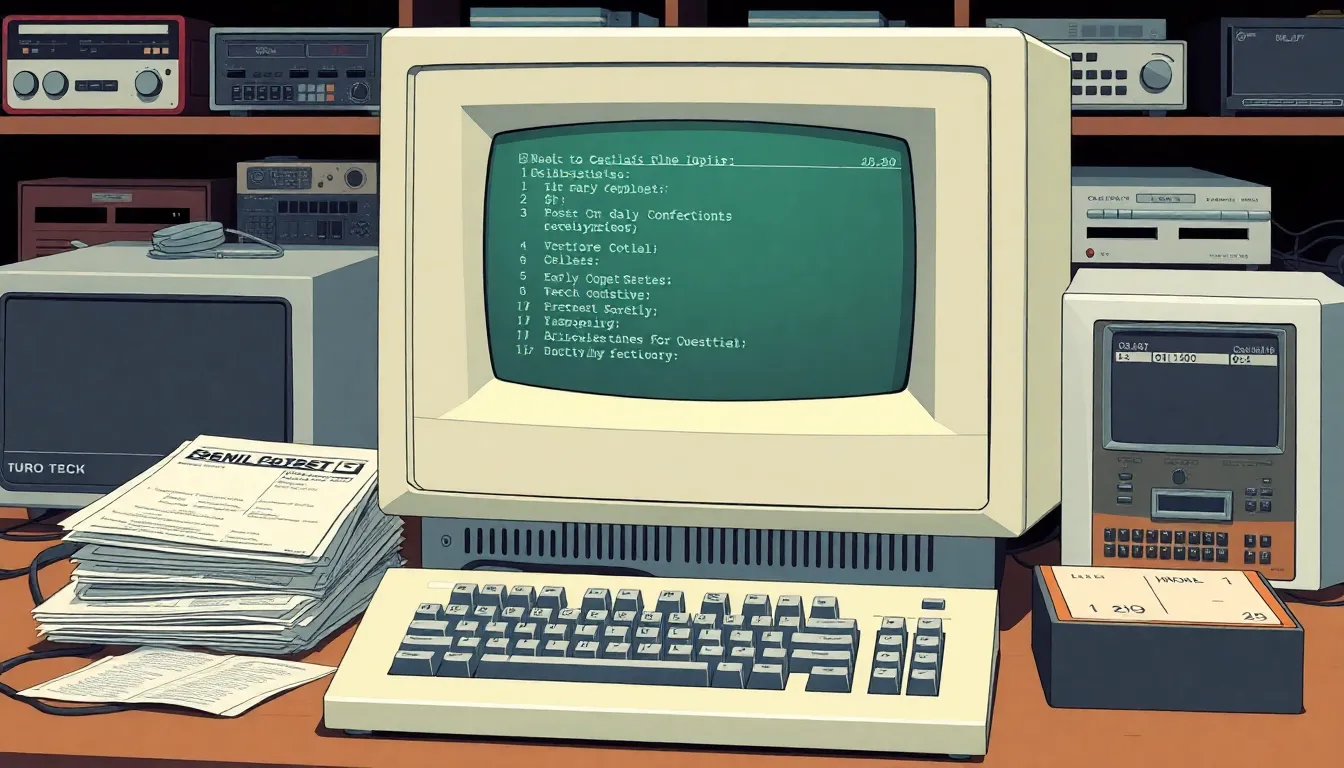From the clunky punch cards of the past to today’s sleek, high-level languages, programming languages have come a long way. It’s like watching a toddler grow into a tech-savvy adult who can not only order a pizza online but also build a rocket ship with just a few lines of code. The evolution of these languages reflects not just technological advancements but also the ever-changing needs of developers and the digital world.
Imagine trying to code in a language that feels like deciphering hieroglyphics. Thankfully, the programming landscape has evolved to make coding more accessible and enjoyable. Whether you’re a seasoned developer or just dipping your toes into the coding pool, understanding this evolution can help demystify the tools that drive our digital age. Buckle up as we take a humorous yet insightful journey through the fascinating history of programming languages.
Table of Contents
ToggleOverview Of Programming Languages
Programming languages began as simple instructions, operating under strict rules and limitations. Early languages, such as Assembly, allowed direct interaction with the hardware, emphasizing efficiency and speed. However, complexity arose, pushing developers toward more abstract forms of communication.
High-level languages emerged in the 1950s, including Fortran and COBOL, designed for scientific computing and business applications. Each aimed to simplify coding tasks while enhancing readability. This shift made programming accessible to a wider audience.
The 1970s introduced the concept of structured programming, with languages like C entering the scene. C emphasized modularity and reusability, laying the groundwork for future languages. Demand for versatility spurred the development of object-oriented languages in the 1980s, such as C++ and Smalltalk. These focused on code organization and data encapsulation.
Fast-forward to the 1990s and 2000s, and scripting languages like Perl and Python gained popularity. These languages prioritized ease of use, enabling faster development cycles. Java emerged as a significant player, bringing platform independence to the forefront, which broadened application possibilities.
Today, the programming landscape features a mix of languages tailored for different tasks, from web development with JavaScript and PHP to data analysis with R and Scala. Each language continues to evolve, driven by developer needs and technological advancements. Emerging languages like Rust and Go illustrate the ongoing innovation, focusing on safety and concurrency.
These programming languages reflect a rich history shaped by user requirements and technological advancements. With each iteration, they aim to enhance productivity, foster collaboration, and bridge the gap between machine and human understanding.
Early Programming Languages

Early programming languages laid the groundwork for today’s coding environment, emphasizing efficiency and direct control over hardware.
Machine Language
Machine language consists of binary code, the fundamental language that computers understand. It involves a series of zeros and ones that correspond directly to machine instructions. Programs written in machine language execute rapidly due to the absence of translation layers. This low-level language allows programmers to maximize processing speed and optimize resource use. While incredibly efficient, machine language poses challenges in readability and maintainability, often leading to complex programming tasks. Programmers typically find hand-coding in binary to be tedious and error-prone.
Assembly Language
Assembly language offers a slight improvement over machine language by introducing mnemonics for coding instructions. With the use of symbolic representations, it enhances readability and simplifies the coding process. Programmers work with hardware-specific instructions, managing system resources more effectively. Each assembly language correlates closely with machine language, enabling direct translation to binary code. The introduction of assembler programs converts assembly code into machine language, streamlining the development process. Despite improved readability, assembly language remains complex, often requiring deep knowledge of the hardware architecture.
High-Level Programming Languages
High-level programming languages facilitate easier coding by abstracting complex hardware details. They focus on syntax that resembles human languages, making programming more intuitive.
Procedural Languages
Procedural languages emphasize a sequence of actions. C and Pascal exemplify such languages, prioritizing procedure calls to organize code into manageable blocks. Each procedure typically focuses on a specific task, which enhances readability and debugging. These languages guide programmers to outline steps explicitly, promoting structured problem-solving. Additionally, they allow for the development of reusable code libraries, which can streamline workflows in software development.
Object-Oriented Languages
Object-oriented languages center around objects, encapsulating data and behavior together. C++ and Java illustrate this paradigm, promoting principles like inheritance and polymorphism. These concepts allow developers to create flexible and scalable applications. Each class serves as a blueprint, making it easier to model real-world scenarios. Moreover, the collaboration between objects enhances code maintenance, as changes in one part of the system often don’t affect others. This modularity appeals to teams working on large software projects, improving productivity significantly.
Modern Programming Languages
Modern programming languages encompass a variety of paradigms and styles, catering to different technological needs. Notably, scripting languages have become essential for rapid development.
Scripting Languages
Scripting languages, such as JavaScript, Python, and Ruby, focus on automating tasks and enabling quick application development. They allow for straightforward coding and dynamic functionality in web applications. Developers appreciate JavaScript for its role in client-side scripting, facilitating interactive user experiences. Python stands out for its simplicity and versatility, making it popular in web development, data analysis, and machine learning. Ruby, with its elegant syntax, emphasizes developer productivity, enhancing the coding experience. These languages often execute within interpreters, promoting faster testing and deployment cycles.
Functional Languages
Functional languages emphasize function application and immutability, shifting the focus from traditional imperative programming. Languages like Haskell, Lisp, and Scala exemplify this paradigm. Haskell operates on pure functions, minimizing side effects and promoting predictable code execution. Lisp, known for its unique syntax and flexibility, supports powerful macro systems, allowing for code manipulation. Scala integrates functional programming with object-oriented features, enabling a versatile development approach. Adopting functional languages typically results in clearer logic and easier reasoning about code, appealing to developers seeking robust software solutions.
Impact Of Programming Languages On Software Development
Programming languages shape software development significantly. Early languages, such as Assembly, offered direct hardware control, enabling developers to optimize performance. It allowed efficient execution, albeit at the cost of readability.
High-level languages emerged in the 1950s, simplifying tasks and enhancing accessibility through readable syntax. Fortran and COBOL exemplified this shift, laying the foundation for broader developer engagement. By the 1970s, structured programming emerged with languages like C, promoting modularity and code reusability.
Object-oriented languages, including C++ and Smalltalk, revolutionized software creation in the 1980s. These languages encapsulated data and behaviors, making code easier to manage, particularly in large projects. They demonstrated how logical organization impacts productivity and flexibility.
During the 1990s and 2000s, scripting languages like Perl and Python gained popularity due to their user-friendliness. Java contributed platform independence, facilitating cross-environment compatibility. Today, JavaScript and PHP dominate web development, while R and Scala cater to data analysis.
Emerging languages, such as Rust and Go, focus on safety and concurrency, addressing modern software challenges. Each language evolves from user needs and technological advancements to meet diverse requirements.
Different programming paradigms, including functional languages like Haskell and Scala, emphasize clearer logic and immutability. They challenge traditional approaches, offering alternative ways to reason about code and developing robust applications.
Overall, programming languages drive innovation in software development, adapting to the ever-changing tech landscape. Each evolution represents a response to the complexities of modern programming demands.
The journey of programming languages showcases a remarkable transformation reflecting technological progress and user needs. From the rigid constraints of early languages to the flexible and intuitive high-level languages of today, each evolution has played a crucial role in shaping software development. The rise of diverse programming paradigms illustrates the industry’s adaptability in addressing complex challenges.
As developers continue to innovate and explore new languages, the future of programming remains bright. The ongoing refinement of coding practices ensures that both seasoned programmers and newcomers can navigate the ever-changing tech landscape with ease. This evolution not only enhances productivity but also fosters creativity in software creation, paving the way for exciting advancements ahead.






